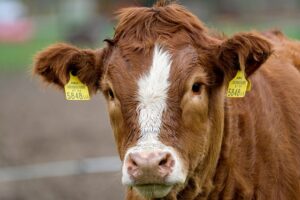Controlling Flies on Cattle
go.ncsu.edu/readext?1063246
en Español / em Português
El inglés es el idioma de control de esta página. En la medida en que haya algún conflicto entre la traducción al inglés y la traducción, el inglés prevalece.
Al hacer clic en el enlace de traducción se activa un servicio de traducción gratuito para convertir la página al español. Al igual que con cualquier traducción por Internet, la conversión no es sensible al contexto y puede que no traduzca el texto en su significado original. NC State Extension no garantiza la exactitud del texto traducido. Por favor, tenga en cuenta que algunas aplicaciones y/o servicios pueden no funcionar como se espera cuando se traducen.
Português
Inglês é o idioma de controle desta página. Na medida que haja algum conflito entre o texto original em Inglês e a tradução, o Inglês prevalece.
Ao clicar no link de tradução, um serviço gratuito de tradução será ativado para converter a página para o Português. Como em qualquer tradução pela internet, a conversão não é sensivel ao contexto e pode não ocorrer a tradução para o significado orginal. O serviço de Extensão da Carolina do Norte (NC State Extension) não garante a exatidão do texto traduzido. Por favor, observe que algumas funções ou serviços podem não funcionar como esperado após a tradução.
English
English is the controlling language of this page. To the extent there is any conflict between the English text and the translation, English controls.
Clicking on the translation link activates a free translation service to convert the page to Spanish. As with any Internet translation, the conversion is not context-sensitive and may not translate the text to its original meaning. NC State Extension does not guarantee the accuracy of the translated text. Please note that some applications and/or services may not function as expected when translated.
Collapse ▲Cattle producers are faced with the task of controlling flies during these warm months of late spring and summer and horn flies and face flies are key pests of cattle in Burke County. Both species breed in fresh pasture manure piles but present very different threats and management problems. Fortunately, there are a variety of fly control options.
Horn flies are blood feeders. They stay on the animals a majority of the time, taking up to 30 small blood meals per day. More than 100 flies along the sides and backs of an animal each day during the fly season can rob producers of 12 to 15 pounds of weaning weight on spring calves and reduce gains on older animals. Because horn flies spend so much time on the animal, many control methods are quite effective.
On the other hand, face flies spend about 90 percent of their time off of the animals and visit them only to feed on liquids around the eyes and face. This makes for difficult control because face flies visit hard-to-treat areas for very short time periods.
One viable control option is insecticide-impregnated cattle ear tags or fly tags, which
release small amounts of an insecticide, distributed over the animal during grooming or rubbing.
Fly tags provide excellent, long-term control of horn flies and some formulations can reduce face fly numbers. Another advantage is that animals only have to be handled twice, at application and removal. Read the label before you purchase and use insecticide ear tags. All tags are labeled for beef cattle while only those with certain active ingredients are approved for use on lactating dairy cattle. Fly tags should be rotated on a yearly basis based on insecticide formulation. Usually, it is best to apply tags after horn fly numbers reach 50 or more per side. This helps reduce the chances of developing resistance to the active ingredients that are being used. Plan on tags providing 12 to 15 weeks of fly control. Tagging too early can mean the tags are not providing control in the fall which helps to reduce the overwintering population.

Photo: NickyPe for Pixaby
Another method of control is pour-on products. These are ready-to-use formulations that are applied to animals in measured doses based upon body weight. Horn flies are killed as they land on treated areas of the animal and pick up the insecticide through their body. Typically, the pour-ons provide about four weeks of fly reduction, and must be reapplied at intervals or used in combination with other methods. The length of control will vary with weather and other factors, so treat again when fly numbers build back up to about 100 per side, but no sooner than the label recommendations.
Many cattle producers prefer self-application devices, such as dust bags, back rubbers, or automatic sprayers for pasture fly control. They can be purchased or homemade. These devices can do a very effective job of horn fly control and may provide satisfactory to excellent face fly control. These all require regular management to insure that they are working and dispensing properly and are not as mobile as other fly control systems. Location is vital for these methods. They must be placed where animals will utilize them regularly. The number needed varies
greatly with animal number, and size of pastures. The ultimate goal is to get each animal treated regularly.
Horn flies and face flies breed in manure in pastures. Manure can be made toxic by having animals consume an insecticide that passes out in the manure. Mineral blocks or loose supplements are available which contain fly control products. This method should be part of a total fly control program as flies will move in from your neighbor’s pasture. Topical control from dust bags or backrubbers is used to deal with these “fly-ins”.
Beef cattle producers have many options for fly control. Cost, effectiveness, and herd
management practices help to narrow this list. If you need more information on fly control, contact the Burke County Cooperative Extension office at 828-764-9480.




